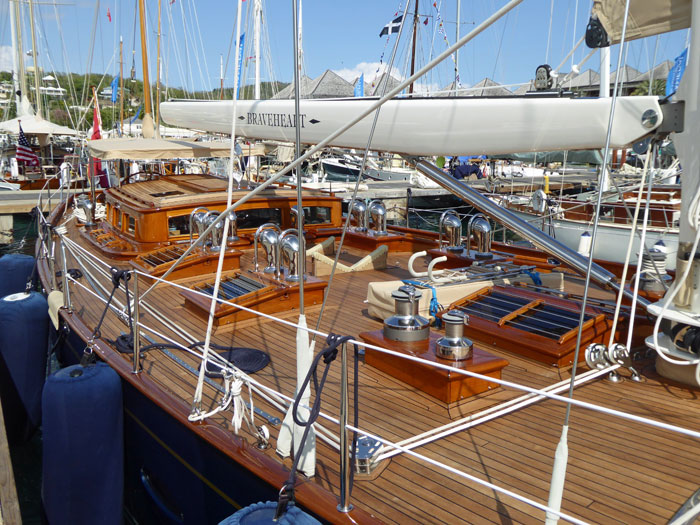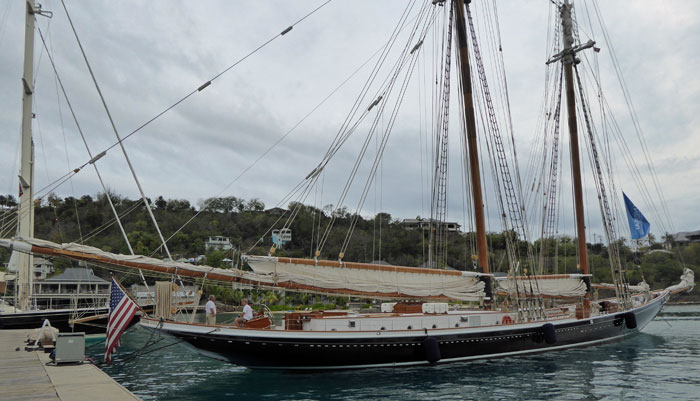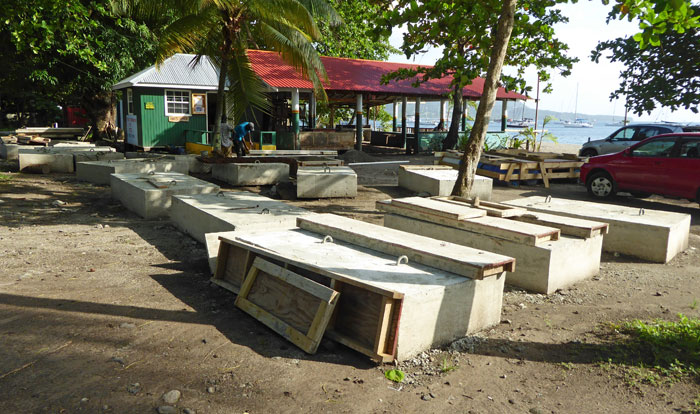| Back to Back Issues Page |
 |
|
The Sailboat Cruiser ~ Issue #28 April 26, 2016 |
HiThe Sailboat CruiserThe Sailboat Cruiser is the free monthly newsletter of sailboat-cruising.com and sets out to bring you the news, views and general musings of, well, me - Dick McClary, a sailboat cruiser and creator/owner of the website. If you like this newsletter, please feel free to email it to your friends. If one of your friends did forward this to you and you like what you read, please subscribe by visiting The Sailboat Cruiser Newsletter #28 - April 2016What's in This Issue:
Classic FantasticsStrolling along the dock in Falmouth Harbour, Mary and I were admiring the stunningly beautiful classic yachts gathered there for Antigua's Classics Regatta.Chatting with another cruising couple doing much the same thing we were surprised to hear them say that these fabulous vessels were "little more than extravagant and ostentatious symbols of their owners' wealth". Well, true to a degree perhaps but we had to disagree with the 'nothing more' bit.
Acres of teak deck and brightwork to maintain on 'Braveheart of Sark'Not only do these magnificent vessels provide employment for their professional crews and support teams, but they bring income to local communities around the world whenever they moor up.The maintenance, operation and running costs must be huge - I doubt there's any profit in it for their owners, but pride of ownership and some serious bragging rights must make it all worth the expense. We applaud the owners for spending their cash in this way, keeping history alive and saving classic vessels of such outstanding beauty for the likes of us to drool over.
'Columbia' - 141 feet of magnificent Classic YachtClassic yachts don't have to be old though. The various classes are:~
Yellow-Flagging itHaving cruised through the Caribbean island chain for a number of years now, there remains a question that I’ve never managed to get a consistent answer to, and it relates to “yellow flagging it” while on passage from one island nation to another. Let me explain with an example...Let’s imagine that we’ve checked out of Customs and Immigration in Bequia (part of St. Vincent & the Grenadines) and are setting off at first light the following day for the French island of Martinique. An average boat speed of six knots or so sees us off the northern end of St. Lucia at dusk, several hours short of our Martinique destination. With just two of us aboard, it would seem seamanlike to drop the hook in Rodney Bay, St. Lucia to get a good night’s sleep before setting off early the following morning for Martinique. I’ve no wish to go ashore, so we fly the Q flag from the starboard spreaders and remain at anchor until daybreak. The question is, am I operating in accordance with International Maritime Law? I’ve discussed this many times with other cruisers, typical answers being: “Sure, it's fine, that’s what we do”, or “Definitely not. You have to clear in”, or even “You’ll be in trouble if you do. I’ve heard of cruisers getting hefty fines for doing just that.” So who’s right? I put this question to Caribbean Compass Magazine in the form of a letter, and with the consent of Sally Erdle (the editor) I've reprinted their reply below...
Good question. The answer seems to be “it depends”: some countries turn a blind eye to “yellow flagging it” and others don’t. We haven’t been able to poll every Customs department in the Caribbean for their stance, but here’s what we can tell you: Starting with the basics, flying the Q flag doesn’t mean, “I want to stop for the night, stay aboard, and move on in the morning”. According to the International Code of Signals, flying the Q flag means, “My vessel is ‘healthy’ and I request free pratique.” There are some slightly different interpretations and applications, but basically pratique is the permission given to a ship to enter port on assurance from the captain that she is free from contagious disease. Free pratique (i.e. the freedom to go about your business once in port) is granted after clearance formalities. So, by flying the Q flag, you are essentially asking to enter a port and clear in. If you don’t intend to clear in, this is at best disingenuous. A related issue is “right of innocent passage”, covered by the United Nations Convention on the Law of the Sea (UNCLOS). This allows for anchoring without clearing in, provided that “Passage shall be continuous and expeditious. However, passage includes stopping and anchoring, but only in so far as the same are incidental to ordinary navigation or are rendered necessary by force majeure or distress or for the purpose of rendering assistance to persons, ships or aircraft in danger or distress.” What makes this risky is that the authorities can interpret “incidental to ordinary navigation” and “rendered necessary” as they choose — if you are challenged, you’ll be relying on somebody’s judgment as to whether or not you’ve broken the law. Anecdotal evidence suggests that the French islands are pretty laissez faire on this, while US territories are more hard line. So it seems that flying the Q flag when you're not intending to clear customs could get you in a spot of bother. Best not to fly it and rely on 'the right of innocent passage' - and take your chances if challenged.
Dominica MooringsDominica has long been one of our favourite Caribbean islands, and Prince Rupert Bay at Portsmouth our anchorage of choice. Alacazam and her crew are always given a warm greeting - "Welcome back Captain and Miss Mary!" - by a member of PAYS (Portsmouth Association of Yacht Services) as he shepherds us to a 'good spot to anchor, captain'. Usually this will be our old friend Martin Carriere on 'Providence', who will have spotted 'Alacazam's' distinctive yellow and white hull.This year though, good spots to anchor were a little harder to find. Along with many other island anchorages, cruisers are encouraged to use the moorings that are being laid. Jeffrey (of 'Seabird'), the current president of PAYS, showed me the next batch of reinforced concrete mooring buoys in construction. They're 8 feet by 4 feet (the size of a standard sheet of ply) by 1.5 feet deep, and weigh 3.5 tons each. "There's 10 down already", he said, "with another 20 to follow". The cost is 10$ US per night, with all income going to support PAYS in their excellent work and services to cruisers.
Formwork removed and ready for launching...I asked Jeffrey how they got the blocks in position on the seabed. It goes like this...Note:~ PAYS is a group of trained certified guides and boat boys that also patrol the north end of Prince Rupert Bay at night during the winter sailing season (November to the end of May) and offer a number of services to cruising boats such as water taxis to customs and immigration, ice, garbage, laundry, fuel and water etc. There are several other Caribbean Island anchorages - notably those in St Vincent - that could learn a lot from PAYS...
Chez FelixNot only is Dominica one of our favourite islands and one of our favourite anchorages (as I may have mentioned several time in the past), it also has one of our favourite beach bars - 'Chez Felix'.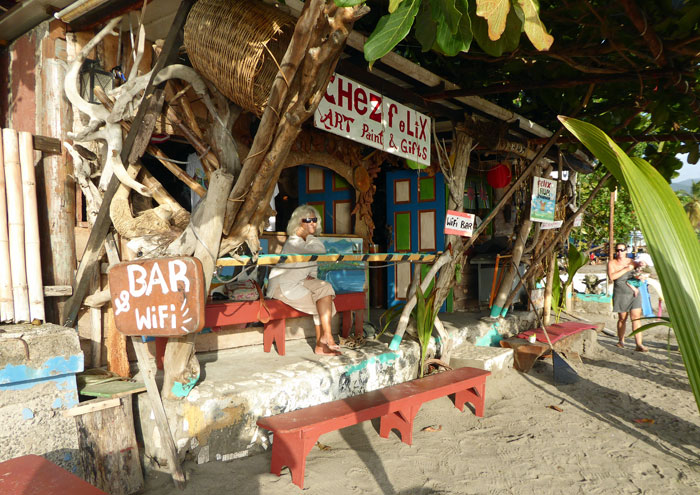
It's not your average beach bar...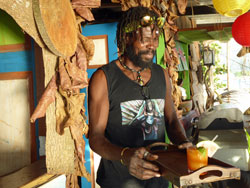
Here's the man himself - and he's not your average barman! Not only does Felix mix one of the best rum punches known to man, he's also a talented artist. He built his bar some years ago with carefully chosen driftwood and anything else he could get his hands on locally. It's a fun place to be, and a great spot to watch the sun go down in the hope of seeing the green flash. It's an established fact that the likelihood of seeing the green flash is directly proportional to the number of Felix's rum punches you've supped. I've seen lot's of them...
Rainwater Catcher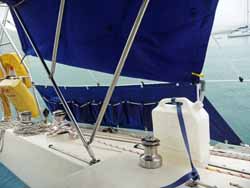 It's said that there's no such thing as a free lunch, but if you rig up a rainwater catcher you can get a free drink.
It's said that there's no such thing as a free lunch, but if you rig up a rainwater catcher you can get a free drink.
You can either have a purpose-made canvas version or just create a lash-up like ours that diverts rainwater from Alacazam's bimini to plastic water canisters. All we do is fold the lower half of the sidescreen back up so that the rain running off the bimini collects in the fold and flows into the flexible plastic pipe clipped to the downstream end of it. In a typical tropical downpour it only takes a few minutes to fill both canisters. One things for sure - just as soon as you've cobbled it all together it will stop raining! Read more about rainwater catchers...
Dinghy Safety TipsLast month's tale - 'A Nocturnal Dinghy Adventure'- about a couple who nearly came to grief through strong drink and an ill-equipped dinghy brought a number of comments. One referring to the effect of alcohol on safety, and others to just what gear we should carry in our dinghies when we travel'twixt yacht and shore. Here's what I'd recommend...As well as wearing lifejackets or buoyancy aids and attaching yourself to the engine kill-cord - which of course you always do anyway - standard safety equipment should include: If, like me, you use your dinghy for fishing you should take particular care in an offshore breeze – as is almost always the case when fishing in one of the Caribbean anchorages. With most anchorages on the leeward side of the islands, engine failure could mean being driven rapidly offshore in the brisk north-easterly tradewinds. Without water or shelter, and with your next landfall several hundred miles away on the coast of Venezuela, the odds of survival aren’t in your favour. Tragically, local fishermen are lost this way far too frequently.
Used Sailing Gear & Equipment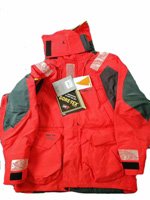 It's always worth checking what's been uploaded to this section of the website.
It's always worth checking what's been uploaded to this section of the website.
Just a couple of days ago this brand new and unused Musto Gore-Tex HPX Ocean Jacket was on offer at little more than half its recommended retail price.
More 'Likes' Please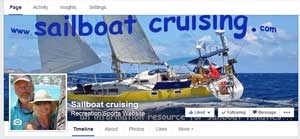 Sailboat-Cruising.com has a Facebook Page!
Sailboat-Cruising.com has a Facebook Page!
Clicking the image here will take you right to it, where you can browse through many more posts and articles. Please take a look, and feel free to make a post - and don't forget to 'Like' us of course... Thanks! Visit sailboat-cruising.com's Facebook Page... And finally...If you know anyone who might be interested in the contents of this newsletter, feel free to email it to them. It's not secret!And this newsletter can be a two-way thing. If you've read anything you'd like to comment on, or perhaps there's an event you'd like to see announced in a future newsletter, then please let me know. See you next month! 
Go to Sailboat-Cruising.com's Home Page... |
| Back to Back Issues Page |
